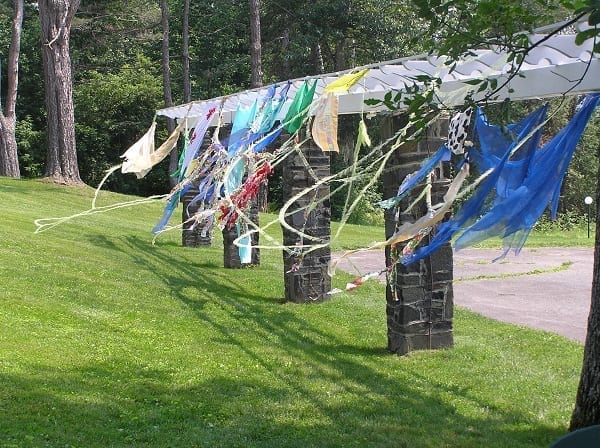In the 21st century, every community needs to be a center of creative transformation and aesthetic engagement. Our low-residency MFA in Interdisciplinary Arts (MFAIA) enables you to advance your creative practice, remaining embedded in the place where you live and work, while also participating in a supportive academic community.
Each semester begins with an intensive eight-day residency focused on developing your academic plan, expanding your perspective, and learning within a community of artists. Informed by philosophies of participatory, democratic education, our educational approach not only accommodates the complexity of your life, but also expands the scope of your practice to include new colleagues, opportunities for showing work, and networks of practice across the world.
The MFAIA program is designed to help you articulate and engage with an original vision, discover new creative opportunities, and refine your critical and expressive skills. As you work to develop your personal practice, the program supports you in understanding a broad range of strategies and dialogues that inform contemporary art at this historic moment.
SELF-DIRECTED | COMMUNITY-ENGAGED
No two artists are alike and no other MFA program places you – the artist – truly at the center of your education. Based on your unique interests, intentions, and professional goals, you will design and pursue an individualized course of study, in dialogue with faculty advisors — themselves accomplished and evolving artists — who work with you one-to-one, challenging you to hone your vision while providing personalized feedback, guidance, and support. This mode of self-directed, dialogic learning and challenge to develop a constellation of lineages that your work engages instills a dedication in each artist.
The MFAIA views learning and artmaking as social processes, providing opportunities for peer-learning, collaborations, and projects. The dialogue that emerges with your advisor and peers, through collaborative learning opportunities, allows you to explore the creative possibility that exists between fields of knowledge and artistic traditions. Interdisciplinary work undertaken in the program, such as recent student projects that combine art and ecology, spiritual and aesthetic practices, and traditional artisan techniques with community development, not only introduce you to currents in contemporary art, but also provide examples of how the arts can be woven into public life.
Concentrations
The Faculty
The MFAIA Program Faculty members work one-on-one with students as faculty advisors throughout the semester, as well as facilitating group studies, teaching workshops at residency, and acting as second readers to students’ final projects. Our faculty is comprised of national and international scholar practitioners with extensive experience supporting students taking charge of their learning. Faculty members’ work with students is focused, clear, and rigorous.
Degree Requirements
The low-residency MFA in Interdisciplinary Arts Program is a five-semester, 60-credit terminal degree program designed to facilitate students in articulating an original vision, refining expressive skills, and experimenting in new directions.
Students will attend 8 day residencies at the beginning of each semester. During this time, in collaboration with faculty, students will craft study plans which guide their individually designed learning goals and activities. One-to-one work with faculty, as well as collaborative and group learning, takes place over the course of 15 week semesters.
To earn the MFA in Interdisciplinary Arts degree, students must successfully fulfill the program’s Degree Requirements, which include:
- Fulfillment of the Degree Criteria supports their holistic, integrated development of expressive, aesthetic, and process skills; critical exploration and articulation of their practice within historical, theoretical, cultural and other relevant contexts; and strategies for ethical engagement with audience, communities, and the world.
- Residency Participation builds discourse and community, as they engage in workshops, presentations, and dialogue on contemporary issues in art-making with faculty, peers and guest artists.
- Practicum Project invites them to explore, through practical experience, the diversity of roles artists might play, and new possibilities for living and working in the world.
- Sharing Work at residency allows them to fully engage their community of peers in a teaching/learning moment, receive feedback and strengthen presentation skills.
- Culminating Degree Portfolio documents and synthesizes the essential character of their work, integrating practice, research and theory.
- Final Presentations contribute the research, new knowledge, and evolving practice they have constructed while in the program back to the community.
Locations
Twice a year, at the start of each semester, students attend an intensive eight-day residency at the College’s Plainfield, Vermont campus, Goddard’s historic main campus, or the Port Townsend, Washington campus a vibrant arts community on the Pacific Coast. The Plainfield campus is located on the homelands of the Abenaki, and the Port Townsend campus is located near the homelands of the Klallam/S’klallam sister tribes—Jamestown S’klallam, Port Gamble S’klallam, Makah, Quinault, and Lower Elwha Klallam. Residencies are a rich time of exploration, connection, and planning.
During the application process, students choose one of the two residency site options for the duration of their studies. Each program site is home to a lively community of interdisciplinary artists and allows them to engage with a unique physical landscape in a retreat-like setting.
Goddard College programs operating in Washington State are authorized by the Washington Student Achievement Council. For more information, please refer to Accreditation and Approvals.
